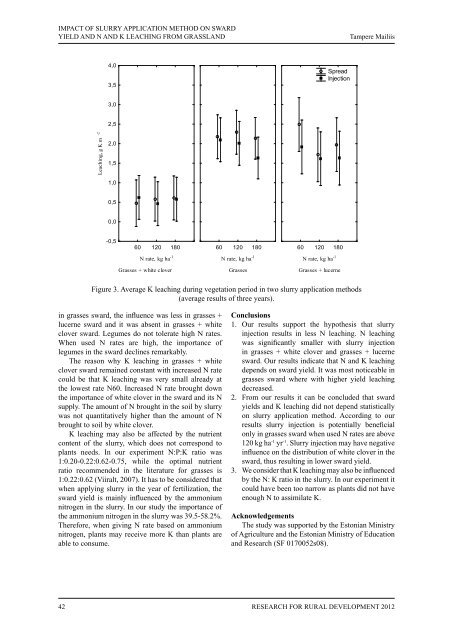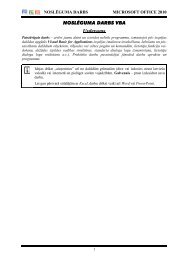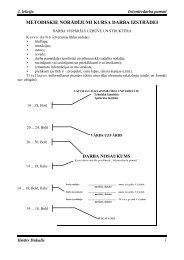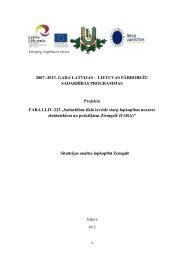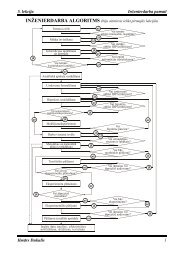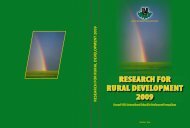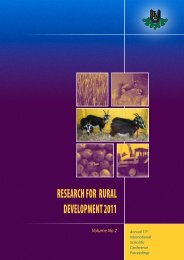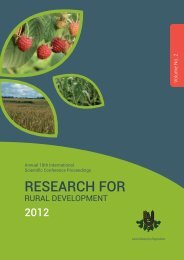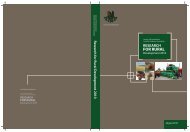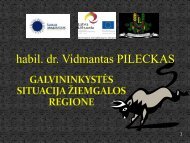- Page 1 and 2: Volume No. 1Annual 18th Internation
- Page 3 and 4: Research for Rural Development 2012
- Page 6 and 7: ContentsFOOD SCIENCESVETERINARYMEDI
- Page 8 and 9: AGRICULTURAL SCIENCES (CROP SCIENCE
- Page 10 and 11: Mihails Vilcāns, Jūlija Volkova,
- Page 12 and 13: Mihails Vilcāns, Jūlija Volkova,
- Page 14 and 15: AGRICULTURAL SCIENCES (CROP SCIENCE
- Page 16: Berit TeinEFFECT OF ORGANIC AND CON
- Page 19 and 20: AGRICULTURAL SCIENCES (CROP SCIENCE
- Page 21 and 22: Methane producing bacteria use only
- Page 23 and 24: according to calculations the metha
- Page 25 and 26: AGRICULTURAL SCIENCES (CROP SCIENCE
- Page 27 and 28: CHANGES IN SUGAR CONTENT OF WINTERO
- Page 29 and 30: CHANGES IN SUGAR CONTENT OF WINTERO
- Page 31 and 32: CHANGES IN SUGAR CONTENT OF WINTERO
- Page 33 and 34: PERENNIAL GRASSES FOR BIOENERGY PRO
- Page 35 and 36: PERENNIAL GRASSES FOR BIOENERGY PRO
- Page 37 and 38: PERENNIAL GRASSES FOR BIOENERGY PRO
- Page 39 and 40: AGRICULTURAL SCIENCES (CROP SCIENCE
- Page 41: IMPACT OF SLURRY APPLICATION METHOD
- Page 45 and 46: AGRICULTURAL SCIENCES (CROP SCIENCE
- Page 47 and 48: IMPACT OF ORGANIC PRODUCT EXTRACTS
- Page 49 and 50: IMPACT OF ORGANIC PRODUCT EXTRACTS
- Page 51 and 52: AGRICULTURAL SCIENCES (CROP SCIENCE
- Page 53 and 54: COMBUSTION ABILITY OF ENERGY CROP P
- Page 55 and 56: COMBUSTION ABILITY OF ENERGY CROP P
- Page 57 and 58: AGRICULTURAL SCIENCES (CROP SCIENCE
- Page 59 and 60: RESEARCH OF OREGANO (ORIGANUMVULGAR
- Page 61 and 62: RESEARCH OF OREGANO (ORIGANUMVULGAR
- Page 63 and 64: INFLUENCE OF SOIL MODIFICATION ON C
- Page 65 and 66: INFLUENCE OF SOIL MODIFICATION ON C
- Page 67 and 68: INFLUENCE OF SOIL MODIFICATION ON C
- Page 69 and 70: INCIDENCE OF POSTHARVEST ROT OF CRA
- Page 71 and 72: INCIDENCE OF POSTHARVEST ROT OF CRA
- Page 73 and 74: AGRICULTURAL SCIENCES (CROP SCIENCE
- Page 75 and 76: PERSPECTIVES ON TRUFFLE CULTIVATION
- Page 77 and 78: PERSPECTIVES ON TRUFFLE CULTIVATION
- Page 79 and 80: PERSPECTIVES ON TRUFFLE CULTIVATION
- Page 81 and 82: FACTORS AFFECTING GOAT MILK YIELDAN
- Page 83 and 84: FACTORS AFFECTING GOAT MILK YIELDAN
- Page 85 and 86: FACTORS AFFECTING GOAT MILK YIELDAN
- Page 87 and 88: MILK UREA CONTENT AS INDICATOR FEED
- Page 89 and 90: MILK UREA CONTENT AS INDICATOR FEED
- Page 91 and 92: MILK UREA CONTENT AS INDICATOR FEED
- Page 93 and 94:
REHYDRATION KINETICS OF DRIED LATVI
- Page 95 and 96:
REHYDRATION KINETICS OF DRIED LATVI
- Page 97 and 98:
REHYDRATION KINETICS OF DRIED LATVI
- Page 99 and 100:
FOOD SCIENCESPreliminary RESULTS of
- Page 101 and 102:
PRELIMINARY RESULTS OF 1-METHYLCYCL
- Page 103 and 104:
FOOD SCIENCESSensory PROPERTIES and
- Page 105 and 106:
SENSORY PROPERTIES AND CHEMICAL COM
- Page 107 and 108:
SENSORY PROPERTIES AND CHEMICAL COM
- Page 109 and 110:
SENSORY PROPERTIES AND CHEMICAL COM
- Page 111 and 112:
THE SUITABILITY OF DIFFERENT ROWANB
- Page 113 and 114:
THE SUITABILITY OF DIFFERENT ROWANB
- Page 115 and 116:
THE SUITABILITY OF DIFFERENT ROWANB
- Page 117 and 118:
THE SUITABILITY OF DIFFERENT ROWANB
- Page 119 and 120:
CHEMICAL COMPOSITION OF NEW TYPE AG
- Page 121 and 122:
CHEMICAL COMPOSITION OF NEW TYPE AG
- Page 123 and 124:
CHEMICAL COMPOSITION OF NEW TYPE AG
- Page 125 and 126:
FOOD SCIENCESINFLUENCE OF GENOTYPE
- Page 127 and 128:
INFLUENCE OF GENOTYPE AND HARVEST T
- Page 129 and 130:
INFLUENCE OF GENOTYPE AND HARVEST T
- Page 131 and 132:
INFLUENCE OF GENOTYPE AND HARVEST T
- Page 133 and 134:
ROOT VEGETABLES FROM LATVIA:QUANTIT
- Page 135 and 136:
ROOT VEGETABLES FROM LATVIA:QUANTIT
- Page 137 and 138:
ROOT VEGETABLES FROM LATVIA:QUANTIT
- Page 139 and 140:
CONTENT OF SUGARS, DIETARY FIBRE AN
- Page 141 and 142:
CONTENT OF SUGARS, DIETARY FIBRE AN
- Page 143 and 144:
CONTENT OF SUGARS, DIETARY FIBRE AN
- Page 145 and 146:
RHEOLOGICAL PROPERTIES OF TRITICALE
- Page 147 and 148:
RHEOLOGICAL PROPERTIES OF TRITICALE
- Page 149 and 150:
RHEOLOGICAL PROPERTIES OF TRITICALE
- Page 151 and 152:
acceptance and preference especiall
- Page 153 and 154:
CONSUMERS’ ATTITUDE TOWARDS AVAIL
- Page 155 and 156:
CONSUMERS’ ATTITUDE TOWARDS AVAIL
- Page 157 and 158:
PHYSICAL - CHEMICAL CHARACTERIZATIO
- Page 159 and 160:
PHYSICAL - CHEMICAL CHARACTERIZATIO
- Page 161 and 162:
FOOD SCIENCESTHE INFLUENCE OF DIFFE
- Page 163 and 164:
THE INFLUENCE OF DIFFERENT SELENIUM
- Page 165 and 166:
FOOD SCIENCESINVESTIGATIONS INTO TH
- Page 167 and 168:
INVESTIGATIONS INTO THE ENHANCEMENT
- Page 169 and 170:
INVESTIGATIONS INTO THE ENHANCEMENT
- Page 171 and 172:
INVESTIGATIONS INTO THE ENHANCEMENT
- Page 173 and 174:
INFLUENCE OF PACKAGING CONDITIONSON
- Page 175 and 176:
INFLUENCE OF PACKAGING CONDITIONSON
- Page 177 and 178:
FOOD SCIENCESFATTY ACID COMPOSITION
- Page 179 and 180:
FATTY ACID COMPOSITION OF THE MEAT
- Page 181 and 182:
FATTY ACID COMPOSITION OF THE MEAT
- Page 183 and 184:
ANTIMICROBIAL RESISTANCE OFANIMAL P
- Page 185 and 186:
ANTIMICROBIAL RESISTANCE OFANIMAL P
- Page 187 and 188:
ANTIMICROBIAL RESISTANCE OFANIMAL P
- Page 189 and 190:
VETERINARY MEDICINETHE SURVIVAL OF
- Page 191 and 192:
THE SURVIVAL OF LISTERIA MONOCYTOGE
- Page 193 and 194:
THE SURVIVAL OF LISTERIA MONOCYTOGE
- Page 195 and 196:
THE SURVIVAL OF LISTERIA MONOCYTOGE
- Page 197 and 198:
VETERINARY MEDICINEMicrobiological
- Page 199 and 200:
MICROBIOLOGICAL QUALITY OF COWS’
- Page 201 and 202:
MICROBIOLOGICAL QUALITY OF COWS’
- Page 203 and 204:
MICROBIOLOGICAL QUALITY OF COWS’
- Page 205 and 206:
PORCINE CIRCOVIRUS-2 IMPACT ON THEM
- Page 207 and 208:
PORCINE CIRCOVIRUS-2 IMPACT ON THEM
- Page 209 and 210:
PORCINE CIRCOVIRUS-2 IMPACT ON THEM
- Page 211 and 212:
PORCINE CIRCOVIRUS-2 IMPACT ON THEM
- Page 213 and 214:
AORTIC LUMEN DIAMETER AND BLOODPRES
- Page 215 and 216:
AORTIC LUMEN DIAMETER AND BLOODPRES
- Page 217 and 218:
AORTIC LUMEN DIAMETER AND BLOODPRES
- Page 219 and 220:
PHYSICAL MODEL OF TRACTOR IMPLEMENT
- Page 221 and 222:
PHYSICAL MODEL OF TRACTOR IMPLEMENT
- Page 223 and 224:
PHYSICAL MODEL OF TRACTOR IMPLEMENT
- Page 225 and 226:
SOLID FUEL BOILER AUTOMATION FOR BR
- Page 227 and 228:
SOLID FUEL BOILER AUTOMATION FOR BR
- Page 229 and 230:
SOLID FUEL BOILER AUTOMATION FOR BR
- Page 231 and 232:
INVESTMENT COSTS OPTIMIZATION OFMUL
- Page 233 and 234:
INVESTMENT COSTS OPTIMIZATION OFMUL
- Page 235 and 236:
DYNAMIC MODEL OF BIOCHEMICAL NETWOR
- Page 237 and 238:
DYNAMIC MODEL OF BIOCHEMICAL NETWOR
- Page 239 and 240:
EDUCATIONAL SCIENCESCHILDREN WITH S
- Page 241 and 242:
CHILDREN WITH SPECIAL NEEDS FAMILY
- Page 243 and 244:
CHILDREN WITH SPECIAL NEEDS FAMILY
- Page 245:
CHILDREN WITH SPECIAL NEEDS FAMILY


